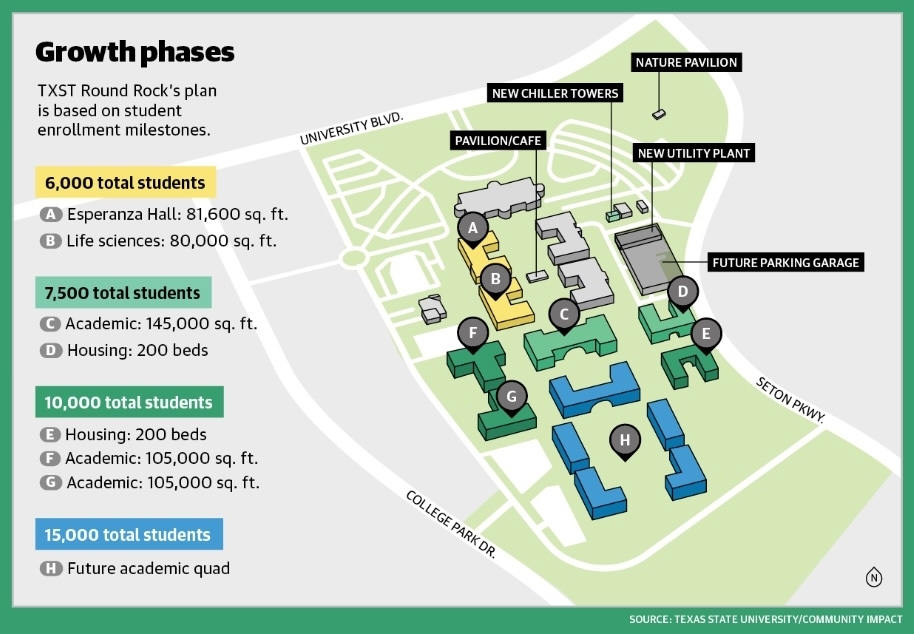The plan would add seven buildings to the existing three across the campus’s 101 acres, including academic halls and student housing.
“What’s exciting is seeing the growth of this campus and seeing what someone had envisioned 25 years ago coming to fruition,” said Julie Lessiter, TXST’s vice president of the Round Rock campus.
Two-minute impact
Texas State University’s Round Rock Campus Master Plan outlines what the campus could look like to support 10,000 students, which Lessiter said the university hopes to reach by 2030.
The plan includes projects for academic buildings, student housing and more, with an emphasis on building communal spaces.
The campus reached an enrollment of 2,193 students this spring—a 21% increase compared to spring 2024—driven by the campus’s first-ever freshman class admitted last fall. The school previously served only upper-level students.
Lessiter said a combination of growth in Williamson County and the absence of universities offering freshman through graduate options in the area has the site “perfectly positioned to be the Texas State northern frontier.”
“There is not an institution that accepts freshmen through graduate students from North Austin to South Dallas,” she said.

Zooming in
At 81,600 square feet, Esperanza Hall, construction on which began in November 2024, will be three-stories tall and feature research labs for science and engineering. Part of the expansion’s first phase, the building will allow students to take lab courses in person.
“Being a campus [predominantly] for nursing and those health professions, labs would be very critical and beneficial for freshmen and sophomores to go on,” said Maryssa Burilson, a sophomore at the Round Rock campus.
Also in the works is a life sciences incubator—a collaboration between TXST, Round Rock Chamber and design firm Concept Companies—to tap into the area’s growing market. Mayor Craig Morgan said the incubator could help Round Rock become more competitive.
“I think that would encourage more companies that may want to actually relocate to Central Texas—more particularly, Round Rock,” he said.Mapping it out
To make room for 7,500 students, TXST will need to build upon the first phase of the master plan by adding more academic buildings and, for the first time, student housing—200 beds—in the second phase.
“You’re friends with the people in your classes, but you sometimes wish you had a strong bond and relationship with them,” said Ana Ramirez, a TXST Round Rock sophomore. “I definitely think adding these residence halls will really help with that.”
The master plan’s future layout organizes student growth around a cross-pattern of quads and open spaces. Alongside the campus’s first quad, TXST’s next academic building would include “an iconic arch” that would mirror Trauth-Huffman Hall in San Marcos, Lessiter said.
“[Students have] all said we really need some space where we can collaborate together, build community and really get to study in a nice environment, and that is going to be achieved with the master plan,” Lessiter said.The local impact
The blueprint for a 10,000-student campus includes an additional 200 beds of housing and two more academic buildings in its third phase, according to the plan.
With a current course offering of 18 undergraduate programs and 11 graduate programs, the third phase would help expand that catalog. Lessiter said the school plans to begin offering an aviation program to help address an ongoing pilot shortage, as well as engineering degrees.
“We’re really all about helping our students get into their careers,” she said. “So having that as our mission is going to draw students to this campus to be able to get their undergraduate degree.”
TXST Round Rock would be the third-largest university in the Austin metro if it reaches a student enrollment of 10,000.
“When these students graduate, if they choose to stay here, live here and work here, then we’re going to get tenfold return from them by what they do in our community,” Morgan said.
Going forward
Between TXST’s main campus in San Marcos, Round Rock campus, satellite locations and online students, Lessiter thinks TXST could grow from its roughly 37,000 students to a goal of 50,000 throughout the entire system.
“The San Marcos campus is pretty landlocked, and there’s a lot of room for growth here,” she said.
With space available, the plan for the Round Rock campus includes a long-term development scenario to accommodate 15,000 students.
Lessiter said the school’s degree programs for health professions could draw more students outside of the Austin metro, such as from Houston, Dallas and San Antonio, and ultimately lend to the university’s 15,000-enrollment mark.
The outline includes expanding the campus southward across the property, with a network of quads made up of academic buildings. This would require upgrades to utilities, water infrastructure, technology and parking, according to the plan.
While enrollment milestones could be years in the making, growth at TXST’s Round Rock campus will continue this fall with its second-ever class of incoming freshmen. TXST President Kelly Damphousse said at a May board of regents meeting that after the campus welcomed its inaugural freshman cohort of roughly 80 students last year, more than 200 are enrolled for the upcoming fall semester.





